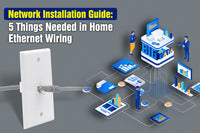Contents
There is no shortage of Ethernet cable issues. A connected office is a happy office, but when the network is on the fritz, you’re likely to hear some complaints. As such, it is imperative to make sure any ethernet cable issues are ironed out before downtime starts to mount.
Where do you start? Well, before we start diving into the ins and outs of LAN cable troubleshooting, we’ll go over a few of the tools of the trade that you’ll want to have on hand. Whether you’re an aspiring network technician or a seasoned pro, you’ll want to have these ready when problems arise.
Around 22% of office issues arise from a lack of network connectivity, according to the Uptime Institute Data Center Resiliency Survey of 2024. With any luck, this can be reduced significantly to focus on other issues within the workplace.
Tools of the Trade
Before setting out to resolve an Ethernet cable problem, there are a few tools you might want to have at the ready. These are well-documented, and just about every network technician worth their pay grade is using these.
A cable or line tester is a must-have. Technicians can check to make sure while troubleshooting Ethernet connections, that the line has continuity. Additionally, a pair of wire crimpers and a punch-down tool are always great to have on hand. If the technician is just testing network cables in a smaller office space, they can do without the latter, however.
Finally, a good tone generator comes in handy. There are other tools, but these are the bare essentials when it comes to troubleshooting the hardware side of things. It is also heavily suggested that the technician has a passing familiarity with your operating system’s command line interface.
Diagnosing Ethernet Cable Issues
Before diving in, here are the most common causes for network cable troubleshooting:
- User negligence: This is where you’ll see cables plugged incorrectly, or not following the floor plan for your current office network.
- Cabling errors: Improper pinouts can be a leading cause for this, as well as a lack of proper labeling when running new lengths of cable to a network device.
- Operating system and software misconfiguration: It isn’t just hardware worth considering, but the software end of things can lead to a loss of network functionality.
- Damage to Ethernet cables: While cabling is sturdy, it is prone to damage like anything else. When exceeding the bend radius, this can result in a complete loss of network transmissions.
Checking the Cabling and Verifying Functionality
The best place to start is on the hardware side of things, believe it or not. Often, it can be as simple as the cable’s connection going to the wrong destination. If everything checks out, then it is time to move to the software side of things. Windows, Linux, and Mac OS all have a command line interface, and a command to ping a server.
Typically, seasoned technicians test external network access by pinging Google’s DNS, 8.8.8.8. Through Windows, Linux, and Mac OS, you can accomplish this by using a command like the following: ping 8.8.8.8. You should receive a TTL along with each packet sent to the destination. If you’re experiencing timeouts on all four packets, then there is a more severe problem at play.
Operating System and Network Adapter Settings
Further, a quick check of the network adapter’s settings can unveil potential issues. Misconfiguration of the DNS, VPN, and so forth can cause a workstation’s connectivity grinding to a halt.
After preliminary checks from the hardware and software side of things, any technician is looking at the more tedious portion of network cable troubleshooting. Line testers come in handy at this step for guaranteeing continuity for the full run of the cabling. A tone generator can also be used.
Checking for Damage and Other Issues
Take care that the cabling hasn’t exceeded its stated bend radius, as this can result in far more severe Ethernet cable problems. A simple crook in the cable can create shorts, which in turn leads to network connectivity issues. If packets are dropping during the ping test but a few slip through, this is a likely culprit.
More often than not, most technicians will find that network cable troubleshooting is on the software side of things. Operating system updates and operator errors are common causes for network adapter misconfiguration.
Fixing Ethernet Cable Problems
At this point, the problem cable should be identified. There are two main options: you can replace the cable outright, or you can splice the damaged portion. They both accomplish the same goal, but it’ll depend on the needs of the situation. If it’s something like an absent-minded intern who rolled a chair over the cable, it might only be a damaged section of a few centimeters or inches to contend with.
However, if there are multiple shorts, it might just be worth running a new length of cable. Costs can mount fairly quickly, so make sure to choose the best option for your current situation.
Guaranteeing Cable Integrity
Further, it is worth making sure the connection is terminating to the proper pinout chart. For the sake of modernity, just go with T568B, unless you’re running older cabling in a legacy setup. This is a basic task for any network technician. If running new cable, this isn’t so much an issue. However, just make sure to remember the color order if replacing and splicing a length of cable in.
Once this is completed, go back to the affected workstation. Guarantee there are no pending operating system updates, drivers are current, and the network adapter looks as it should. Run the ping test again. With any luck, any technician should see the packets going through with minimal latency on the TTL. If not, it is time to repeat the network cable troubleshooting process described in the previous section to get back on track.
When testing the connection, make sure that any wireless network access is shut off. Wireless network connectivity can show as positive connections but can lead any network technician to a feeling of false confidence.
Preventing Ethernet Cable Issues
Beyond just solving issues, some basic hygiene and etiquette go a long way to maintaining the health of your cables. You don’t want to extend the bend radius, so if dealing with corners, maybe run a little extra. All connections to termination points should be stable. Further, make sure the connector at the end of your cable has the proper wiring with a secure connection. These are common reasons for the failure of a network cable.
A high-quality Ethernet cable and durable Ethernet connectors ensure long-lasting performance, and you can enjoy networking benefits for years to come.

Typically, it is less an issue of the cable’s age, but more of misuse or neglect. As such, when looking to have an efficient and functional network closet, you’ll want to take care of your cables. Additionally, clear labeling of each cable on your switch or router can also make future diagnoses of potential issues a breeze. If the network cabling is a rat’s nest of loose cables jammed into a switch, then it can become a far greater issue down the line.
Wrapping It Up
Network cable troubleshooting isn’t just a process, but a skill set any network technician should have on hand. Being able to locate and remediate an issue can make a difference between guaranteeing uptime or losing money by the second as you try to get everything back online. Take care of your cables, and they’ll take care of you.
For more information on this topic, you can keep up on our blogs. While VCELINK offers general and basic information for our customers and other visitors to the website, it’s not professional advice.



Be the first one to comment.
Leave a comment